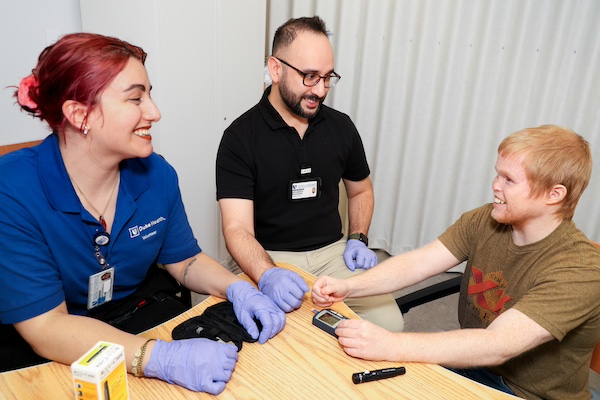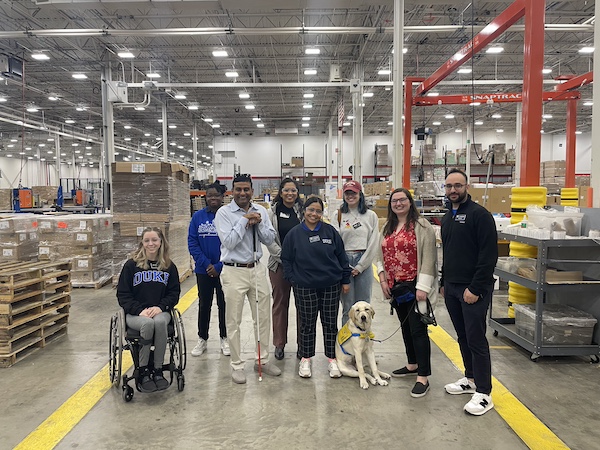
Equipping occupational therapists to empower low vision patients
Today, more than seven million Americans suffer from blindness or low vision — defined as the loss of sight unable to be corrected with prescription glasses, contacts, or surgical interventions. Often caused by age-related disorders like macular degeneration or glaucoma, the number of people impacted by low vision is only expected to rise as the percentage of the U.S. population over 65 surges in the next 20 years. According to recent data, in North Carolina alone the number of residents who are 85 or older will more than double by 2041.
Unlike complete blindness, individuals with low vision often retain some level of sight and for many, the use of visual aids can help to enhance their remaining vision. Symptoms of the condition vary, ranging from blind spots and poor night vision to glare sensitivity and blurry vision, posing unique challenges to their daily routines and independence. With the exponential growth in the number of older adults affected by low vision, there is an increasing demand for trained professionals to provide care and teach fundamental life skills.
In response, the Duke University Occupational Therapy Doctorate (OTD) Program in cooperation with the Duke Eye Center Rehabilitation and Performance Division has launched a groundbreaking Low Vision Certificate. This certificate program, initiated in the academic year 2022-23, addresses the shortage of experienced practitioners equipped to assist people living with vision impairments.
Prioritizing Vision Rehabilitation at Duke
“Despite the fact that vision impairments are steadily climbing, less than 20 percent of academic occupational therapy training programs include specialized coursework in vision disorders and visual impairments,” said Diane Whitaker, OD, Duke Eye Center. “Together our multi-disciplinary team of professionals — with the full support of the Duke University School of Medicine — established this one-of-kind curriculum for training occupational therapy students.”
The Duke OTD vision certificate program is one of only two certificate programs in the nation for entry-level practitioners. This uniquely interconnected training curriculum was developed based on the collaboration and guidance of Whitaker, Tomeico Faison, OTD, OTR/L, Barbara Hooper, PhD, OTR/L, FAOTA and Kimberly Hreha, EdD, OTR/L. As a result of considerable enthusiasm, by its second year the highly sought after program had to establish a competitive application process. Already, nearly 20 students have confirmed their interest in pursuing the Certified Low Vision Therapist (CLVT) certification and recently 12 new participants were accepted into the course of study.
“The success of our inter-departmental collaboration is realized in the hybrid structure and flexibility of this innovative curriculum,” shared Faison. “Through it, occupational therapy students are collaborating with members of the rehab team as well as optometrists and ophthalmologists from the Duke Eye Center Rehabilitation and Performance Division. Together we are equipping the next generation of therapists with the skills required to help patients live fuller lives despite their low vision challenges. It’s inspiring to see the possibilities.”
Program Structure

The comprehensive 14-week course covers essential topics required for the students to earn their CLVT certification, along with specific occupational therapy proficiencies. Participants are engaged through rigorous training that includes topics such as ocular anatomy, interprofessional teamwork, common eye diseases, assessment processes, interventions, community resources, technology, and research.
“The Duke OTD vision certificate program was a rare opportunity for me to receive high-quality low vision education from the best practitioners in the field,” Stephanie Stellato, program participant. “During my fieldwork at Duke Eye Center I gained valuable patient experience and benefitted from the feedback I received from each practitioner and professor. This training has equipped me with the skills I need to be become an occupational therapist who specializes in Low Vision.”
After completing their coursework, students must complete a 350-hour fieldwork or capstone experience before being eligible to take the credentialing exam. This work takes place at leading institutions across the country — including Duke Eye Center — with additional sites under consideration to accommodate the growing number of students pursuing the certificate.
“For decades eye care providers have been anticipating the needs of aging baby boomers and the paucity of resources to meet those needs,” said Whitaker. “This certificate program pairs the expertise of Duke Ophthalmology with the benchmark therapies provided by Duke OTD, equipping specialists to help bridge that gap.”
Vision for the Future
Still in its infancy, Duke OTD is leading the way, becoming a model for the formation of similar courses at other institutions. By cultivating robust partnerships with national organizations such as the American Academy of Ophthalmology, the Academy for Certification of Vision Rehabilitation and other leaders in optometry and occupational therapy, Hooper, Faison, Hreha and Whitaker hope to see this and other programs grow.
“At Duke, we attract and train the best and the brightest. We’re confident that our OTD graduates will be equipped to excel, drive advancements in world of vision rehabilitation and help low vision patients thrive,” said Hooper.